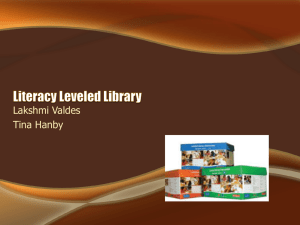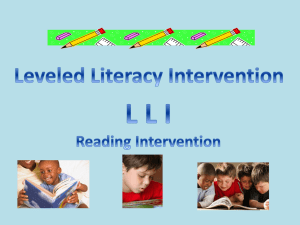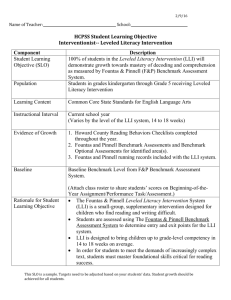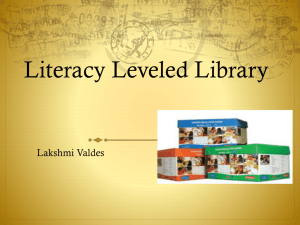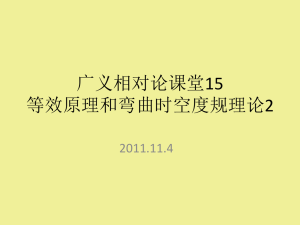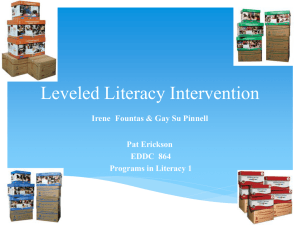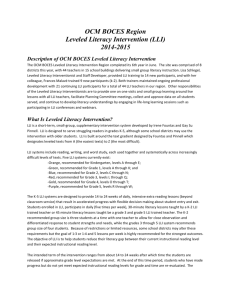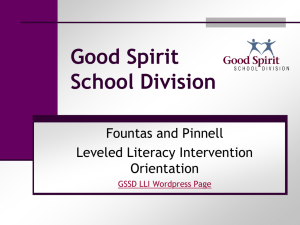OCM Report 2011-12
advertisement
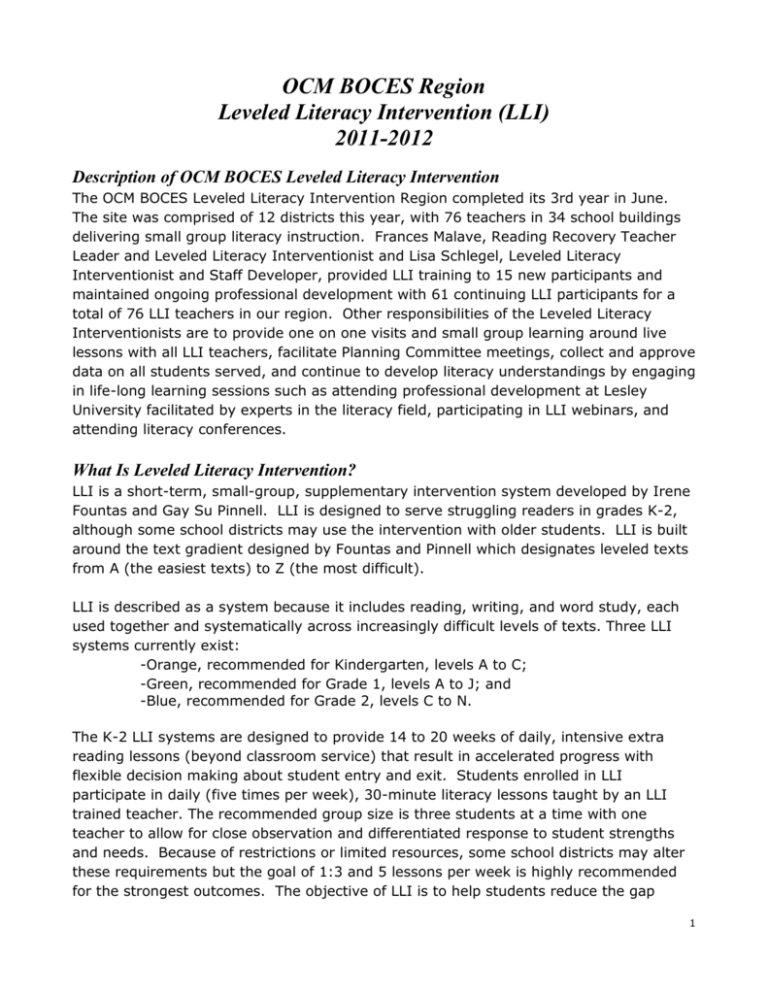
OCM BOCES Region Leveled Literacy Intervention (LLI) 2011-2012 Description of OCM BOCES Leveled Literacy Intervention The OCM BOCES Leveled Literacy Intervention Region completed its 3rd year in June. The site was comprised of 12 districts this year, with 76 teachers in 34 school buildings delivering small group literacy instruction. Frances Malave, Reading Recovery Teacher Leader and Leveled Literacy Interventionist and Lisa Schlegel, Leveled Literacy Interventionist and Staff Developer, provided LLI training to 15 new participants and maintained ongoing professional development with 61 continuing LLI participants for a total of 76 LLI teachers in our region. Other responsibilities of the Leveled Literacy Interventionists are to provide one on one visits and small group learning around live lessons with all LLI teachers, facilitate Planning Committee meetings, collect and approve data on all students served, and continue to develop literacy understandings by engaging in life-long learning sessions such as attending professional development at Lesley University facilitated by experts in the literacy field, participating in LLI webinars, and attending literacy conferences. What Is Leveled Literacy Intervention? LLI is a short-term, small-group, supplementary intervention system developed by Irene Fountas and Gay Su Pinnell. LLI is designed to serve struggling readers in grades K-2, although some school districts may use the intervention with older students. LLI is built around the text gradient designed by Fountas and Pinnell which designates leveled texts from A (the easiest texts) to Z (the most difficult). LLI is described as a system because it includes reading, writing, and word study, each used together and systematically across increasingly difficult levels of texts. Three LLI systems currently exist: -Orange, recommended for Kindergarten, levels A to C; -Green, recommended for Grade 1, levels A to J; and -Blue, recommended for Grade 2, levels C to N. The K-2 LLI systems are designed to provide 14 to 20 weeks of daily, intensive extra reading lessons (beyond classroom service) that result in accelerated progress with flexible decision making about student entry and exit. Students enrolled in LLI participate in daily (five times per week), 30-minute literacy lessons taught by an LLI trained teacher. The recommended group size is three students at a time with one teacher to allow for close observation and differentiated response to student strengths and needs. Because of restrictions or limited resources, some school districts may alter these requirements but the goal of 1:3 and 5 lessons per week is highly recommended for the strongest outcomes. The objective of LLI is to help students reduce the gap 1 between their current instructional reading level and their expected instructional reading level. The intended term of the intervention ranges from about 14 to 18 weeks after which time the students are released if approximate grade level expectations are met. At the end of this time period, students who have made progress but do not yet meet expected instructional reading levels for grade and time are re-evaluated. The evaluation may suggest more time in LLI lessons or an alternative intervention (such as individual tutoring). Students who have not received a full program of services and are in the intervention at the end of the school year may continue to receive service at the beginning of the next school year. Some students who participate in the intervention may have achievement levels more than a year below grade level. Although these students may not achieve grade level performance in the short term, steady progress may warrant longer term service if resources allow for service to continue. Background on LLI Data Collection, 2011-2012: In response to LLI Planning Committee feedback in the fall of 2011, the data collection process and timing was revised to assist the group in consideration of the question: Is Leveled Literacy Intervention an effective and efficient intervention in Central New York? The initial data collection tool (Survey Monkey format) from 2010-11 was revised with questions added to gather additional information. To better collect student specific information an additional tool in spreadsheet format was also revised by the committee. Thus, the data collection process evolved to consist of two tools, one for program data and one for student progress data, which were completed in two time intervals. At mid-year, student progress data was collected. Planning Committee members were, at their request, notified of who had completed the data form. This mid-year data collection occurred over a range of several weeks. At the end of the school year, teachers updated the student progress spreadsheet, which was forwarded to Lynn Radicello. Again, planning committee members were notified of the status of data completion for their district. (It should be noted that some of this data was incomplete). Additionally, at the end of the year, teachers completed the data collection tool regarding the program through Survey Monkey. All data was aggregated to create the regional profile. Individual district and teacher data is not analyzed here. If you are a planning committee member and would like the raw data to conduct further analysis specific to your district, please contact Lynn Radicello. 2 Leveled Literacy Intervention Program Data Program data was reported for 392 LLI students taught by 45 LLI teachers in 20 schools through survey monkey link. OCM BOCES LLI participants reported data voluntarily. Leveled Literacy Intervention Teachers The table below shows the total number of teachers trained by OCM BOCES LLI Interventionists since 2009. Training by OCM BOCES Region % of Teachers 100% (n= 103) During the 2011-2012 school year, there were 76 LLI participants and only 45 teachers reported their Professional Title at their assigned schools through surveymonkey link. 24.4% (11) reported Reading Teacher as their primary title and 35.6 % (16) reported AIS as their primary title. The second highest percentage 28.9% (13) identified their title as Special Education Teachers. 11.1% (5) are classroom teachers. 3 Teachers responded to what other role(s) they have in the school. 42.2% have no other role, 31.1% teachers identified as Title 1 or reading teachers, 13.3% selected special education teacher, 2.2% participants were staff developers, and none chose ELL, School or District Administrator, or Reading Recovery teacher as their other role. 4 Students Served Teachers reported the number of the instructional groups they served for 2011-2012 school year. 24.4% teachers served 2 groups and 24.4% served 3 groups, 20% served 1 group, 11.1% served 5 groups, 8.9% served 4 groups, 6.7% served 6 groups, 2.2% served 8 groups, and 2.2% served 10 groups. 5 Teachers reported serving 392 students. Of these students, 195 (50%) reached Fountas’ and Pinnell’s grade level expectation and needed no further support, 142 (36%) students needed further support after receiving 18 weeks of the LLI intervention. 126 (32%) students needed longer support and stayed in an LLI group for more than 18 weeks. Included in this group are special education students for whom it is intended to be a yearlong program. 33 (.08%) students received incomplete intervention and 15 (.04%) moved out of district while receiving services. Category* Total students served in LLI groups (See Chart A) Students who accelerated and reached the average reader in the classroom (See Chart B) Students who received the full 18 weeks and were recommended for further support (does not include special education students who were provided a yearlong LLI program) (See Chart C) Students who received longer than 18 weeks of LLI service (includes special education students who were provided a yearlong LLI program) (See Chart D) Students who moved out of the district while being served (See Chart E) Students who were removed from LLI under unusual circumstances with fewer than 18 weeks instruction (See Chart F) Students who did not receive the full number of weeks of intervention because of insufficient time (See Chart G) Students who were considered for retention (See Chart H) Number Percentage 392 100% 195 50% 142 36% 126 32% 15 .04% 28 .07% 33 .08% 28 .07% *Individual students may be counted in more than one category 6 Number of teachers responding Chart A Number of Students 7 Number of teachers responding Chart B Number of Students 8 Number of teachers responding Chart C Number of Students 9 Number of teachers responding Chart D Number of Students 10 Chart E 11 Chart F 12 Chart G 13 Chart H 14 Reasons for the 46.7% teachers for not filling in the open slot for another student: I am only permitted to work w/ students on my caseload, no gen ed students. I didn't have another student who fit. no 3rd graders were low enough for the blue box We had no available vacancy There were no other students available to fill slot I only service special ed. students only one student moved into my LLI group when another left for other services. He did not receive the full 18 weeks under my instruction, but from a reading teacher. I am only able to service my special needs students no one left No one moved out no vacancies this year If there was a move in or someone or we rearranged groups. Otherwise we were not searching for students. We want to maintain the integrity and focus of our group, knowing that is about their ability and the skills being taught more than filling a spot. If there was an student that fit that level Students were shifted to adjust levels being taught never had a vacancy 15 Number of teachers responding Teachers reported on the types of assessment used and the degree to which they used these assessments for LLI placement and exit from the intervention. 16 Concluding Thoughts from Trainers perspective: We have found a great appreciation for LLI among teachers, students & parents who have experienced the intervention in our districts. Teachers have implemented the intervention with fidelity as closely as they can within the constraints of their buildings. They have used varying models of the intervention in order to meet the needs of their students. When we look at the data, we need to be mindful of the progress students have made, which we will further discuss in the next section of this report. 17 Leveled Literacy Intervention Student Progress Data Introduction After gathering information about the LLI program, we analyzed the data regarding individual student progress. Teachers were requested to complete a spreadsheet midyear and at the end of the year providing information about student progress. This data was aggregated into a regional profile. Data from a total of 216 students across 11 districts were included. This was in response to the question: Is Leveled Literacy Intervention effective and efficient for students in Central New York? To assist with determining what is effective and efficient, we referred to the research study conducted by Elizabeth Ward Ph.D., “Leveled Literacy Intervention Research and Data Collection Project 2009-2010” (Executive summary is posted on OCM Literacy Programs Web-page). Her findings are referenced as benchmarks to which our results are compared. Was student progress accelerated during Leveled Literacy Intervention? Using the research developed within Elizabeth Ward’s study, text levels were converted to time equivalent scores. “These scores represent the number of months students, with typical progression, should have completed when they demonstrate the reading behaviors associated with the Fountas and Pinnell levels”. Gain is determined by calculating the difference between the entry and exit time equivalent score. This provides an indication of progress in units of months which is then compared to amount of time students receive instruction in Leveled Literacy. 18 Student Growth Student growth ranged from zero months to 18.5 months. The mean reading gain was 8.0 months. This compares to 8.0 months in the national study. 19 Growth Acceleration: Student growth in time equivalent was compared to time enrolled in Leveled Literacy Intervention to determine if student growth was accelerated. Similar to the national study, our results indicate that student growth was accelerated. While for the purpose of this report, the results from students receiving special education were not disaggregated, districts are encouraged to look at this data. It was noticed that for many students receiving special education supports, their progress was accelerated even though grade expected benchmarks were not achieved. Sixty-eight percent of students demonstrated accelerated growth. Students that did not demonstrate growth were, in many cases, provided with alternative instruction. 20 What degree of reading gain was achieved? To answer this question, text level gains were examined. First we looked at students making at least three text level gains. Time as a variable was not considered. Ninetyone percent of the students made minimum three text level gains. This compares to sixty-eight percent in the national study and 2010-2011 OCM’s results were Seventy-five percent of the students made minimum three text level gains. Gains of a minimum of seven text level gains were also looked at. The OCM BOCES region had 22% of students achieving this significant gain. National study reports 12.5 percent with seven or more text level gains and in 2010-2011, the OCM BOCES region had 18% of students achieving this significant gain. 21 Are students exiting Leveled Literacy Intervention meeting grade level expectations? Within the OCM BOCES region, 36% of the enrolled students exited meeting grade level benchmark whereas last year reports 51% met grade level benchmark. Student’s with Special Needs in the OCM BOCES region, a total of 103 number of students represented in this data, 36% of the enrolled students exited meeting grade level benchmark. It should be noted that this data includes a small percentage of Students with Disabilities received LLI as their core program during 2011-2012. 22 Comparable to the national study, we also looked at students who were “close” to meeting grade level expectations or benchmarks. Our data shows that greater percentages obtained desired outcomes when including students who are within one text level of benchmark. Fifty-five percent are within one text level of benchmark. This compares to 64.8% in the LLI subset of the national study and slightly less to last year’s report which was 59% were within one text level of benchmark. Of the 103 Students with Special Needs, 24 % were “close” to meeting grade level expectations within One Text Reading Level. 23 In the subset of the national study, 79.2% were at or within two text reading levels for grade expectation. In the OCM BOCES region, our data shows 70% at this level of achievement. Students Making Benchmark or within Two Text Reading Levels 2011-2012 30% 70% Students with Special Needs 38% of 103 were two text levels away from reaching grade level expectations (benchmark). 24 Conclusions OCM’s data results seem to indicate that, even if students don’t make grade level expectations or benchmark, 79% of all student’s progress accelerated and 54% of the Students with Special Needs progress accelerated. The data also indicates that students with special needs progressed at the same rate as students in the general education category. Another interesting piece of data captured was that 55% of students were one text level away and a tier one intervention can be implemented to continue their progress while 34% of students were two text reading levels close to reaching benchmark will need further support such as a small group intervention to be certain the gap continues to close. It is recommended that, as a group, we continue to collect and study our results. Report Prepared by: Frances Malave, Lisa Schlegel and Lynn Radicello July 2012 25 Appendix A The following are informal responses made about the LLI program from colleagues, administrators, parents and students: No informal responses were shared from teachers, administrators, parents or students. K "I have seen some great shifts in his learning." "It's nice to have a benchmark system that every other teacher in the school has been trained to use so that we're all on the same page." The structured lessons and pace was just what my students needed. Very excited to see all their student could do when they observed a lesson. The teacher then had new expectations in the classroom and made some group changes that held the child more accountable. They were very excited to see all students were able to do. Parents liked the take-home component. Teachers shared that they were seeing students who perceived themselves as readers. The flow of the lessons lends nicely to best practices in the classroom for literacy centers. Students loved the books and were excited to read! Enthusiasm for reading increased! I did not receive any feedback from parents, teachers, or children in response to the use of this program. I had one out of the six students I had in LLI no longer receive AIS services, but the other 5 students made solid gains. My feeling is many of these students will need to be tested for a learning disability. One student who did quite well is being retained due to his immaturity. The two I picked up later in the year may have gotten to grade level if there was more time. State testing/Aimsweb testing took away a lot of teaching time from these kids. Students enjoyed rereading book. Non-readers also enjoyed looking at the pictures. I have several students express that they sound better when they read. Noted growth of students across the program time period My child really enjoys the take home books. The parent sheets are helpful. I love to read the take home books to my mom and dad Teachers are pleased with the program and the quality of the literature. I was worried about Jalynn's reading, but she is really getting much better with her reading. (the student's mother said this during a phone conversation) parents love the take home text I can't think of anything specific, at the moment, sorry. liked the take- home books, very helpful A new 2nd grade student reading at D, who I thought needed to be sent for a CSE evaluation, is going to 3rd grade reading on grade level after spending all of 2nd grade in LLI. It was wonderful to see special needs students who were considered non-readers read. Parents liked the take home books and info sheet with info about what to review with their child. I am concerned that my LLI groups will occur in the classroom next year. 26 LLI is a great program and most of our students make great growth. Parents and students loved the Take-Home Books. "We love having the books at home to read with our child" I hope our district can afford to buy the Grade 3 LLI kit. It's nice to see the kids reading books. Parents are generally very happy with the intervention for its home books and their child's increase in interest for reading. This was my first year doing LLI, most students made reading gains. Students made slow consistent progress. Strategies were easy to carry over into classroom activities. "I can't believe how much progress they have made in such a short period of time." It's hard to service only 3 students 30-40 mins a day with 24 students in the classroom I love Orson and Taco books- from a student "I love the successes the students are making with LLI." Teachers were very happy with the progress they saw in their students. We can't wait for the 3rd grade boxes!!!!! Most of the gen ed classroom teachers felt that it was too time consuming to be responsible for both the regular reading group for the student, and the AIS LLI groups. students coming into first grade made great progress towards their IEP goals very time consuming when I have a class of 24 to spend 35 minutes with 2or 3 students, though I do believe the program to be of quality Parents were pleased with progress. Students have significant disabilities and made gains at their developmental level. While I have only just started the program and have not yet been able to complete for the full 18 weeks I have observed some nice growth in my students and they really enjoy the program! 27 Appendix B The following are the questions from the surveymonkey link: LLI End of the Year 2011-2012 1. LLI End of Year 2011-2012 Data OCM BOCES Mission Statement - The mission of the Onondaga-Cortland-Madison BOCES is to develop and provide educational programs and services of the highest quality for school districts and the community. OCM BOCES Slogan - "Committed To Your Success" *1. In what district were LLI students served? In what district were LLI students served? *2. In which building were LLI students served? In which building were LLI students served? OCM Cedar Street OCM CTC OCM Homer Elementary OCM Morgan Road OCM McEvoy OCM Onondaga Road OCM Other Barry Elementary Burton Street Elementary Bridgeport Elementary Chestnut Hill Elementary Donlin Drive Elementary East Hill Elementary Elbridge Elementary Elmcrest Elementary Jamesville Elementary Kathryn C. Heffernan Elementary Lake Street Elementary Liverpool Elementary Lyncourt Elementary Moses Dewitt Elementary Onondaga Road Elementary Parker Elementary Ramsdell Elementary Randall Elementary Smith Elementary Solvay Elementary Split Rock Elementary Stonehedge Blue Elementary Stonehedge Gold Elementary Tecumseh Elementary Tully Elementary Virgil Elementary Willow Field Elementary Rockwell Elementary Other *3. What is your title in your building? What is your title in your building? *4. In what other role(s) (if any) do you primarily work in the school ? In what other role(s) (if any) do you primarily work in the school ? have no other role are a Title I or reading teacher a classroom teacher a staff developer 28 a special education teacher an ELL teacher a school or district administrator Reading Recovery *5. How many groups were you able to serve this year? How many groups were you able to serve this year? *6. How many LLI students were able to receive the service? How many LLI students were able to receive the service? *7. How many LLI students accelerated and reached benchmark? How many LLI students accelerated and reached benchmark? *8. How many LLI students received the full 18 weeks and were recommended for further support? (not including the students who were provided additional weeks in LLI) How many LLI students received the full 18 weeks and were recommended for further support? (not including the students who were provided additional weeks in LLI) *9. How many LLI students received longer than 18 weeks of LLI service? How many LLI students received longer than 18 weeks of LLI service? *10. How many LLI students moved out of district while being served? How many LLI students moved out of district while being served? *11. How many LLI students were removed from LLI under unusual circumstances with fewer than 18 weeks of instruction? How many LLI students were removed from LLI under unusual circumstances with fewer than 18 weeks of instruction? Please specify reason *12. If a vacancy occurred in a LLI group was the resulting open slot filled by another child? If a vacancy occurred in a LLI group was the resulting open slot filled by another child? Yes No Sometimes (use provided space to clarify a No or Sometimes response) *13. How many LLI students were receiving the intervention and didn't receive the full number of weeks because of insufficient time to complete the intervention? 29 How many LLI students were receiving the intervention and didn't receive the full number of weeks because of insufficient time to complete the intervention? *14. How many LLI students were considered for retention? How many LLI students were considered for retention? *15. Which assessment system do you use to determine instructional text reading level and exit text reading levels? Which assessment system do you use to determine instructional text reading level and exit text reading levels? DIBELS DRA Fountas and Pinnell Benchmark Assessment System Rigby PM Other *16. Did each student receive a benchmark assessment to determine their entry text level before the LLI placement group? Did each student receive a benchmark assessment to determine their entry text level before the LLI placement group? Yes No *17. Did each student receive a benchmark assessment to determine exit text level after receiving the LLI services? Did each student receive a benchmark assessment to determine exit text level after receiving the LLI services? Yes No *18. What informal responses to LLI did teachers, administrators, parents and students make? For example: The following was shared by a Leveled Literacy Intervention teacher: "This is the very first year I will be able to send all students on grade level!" What informal responses to LLI did teachers, administrators, parents and students make? For example: The following was shared by a Leveled Literacy Intervention teacher: "This is the very first year I will be able to send all students on grade level!" 30
